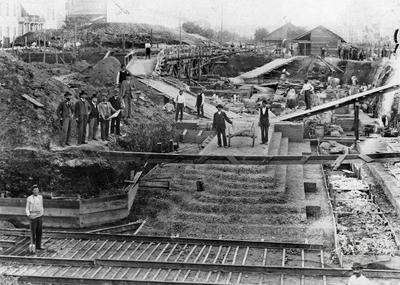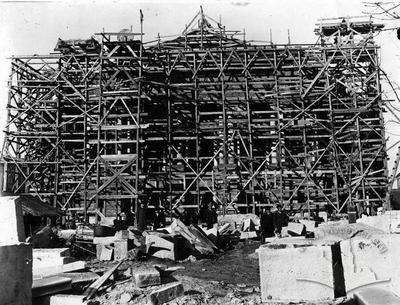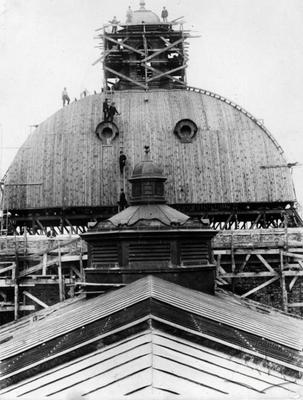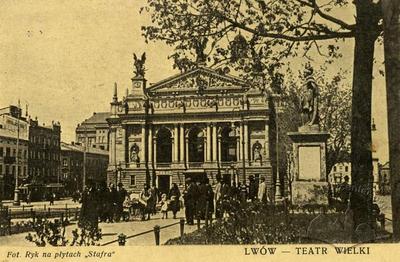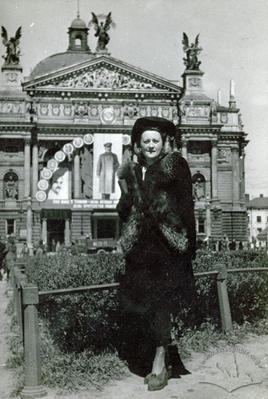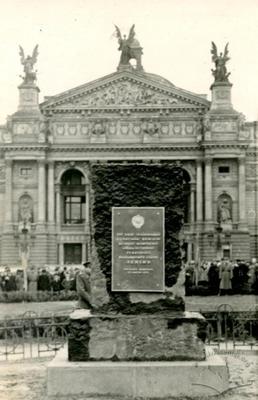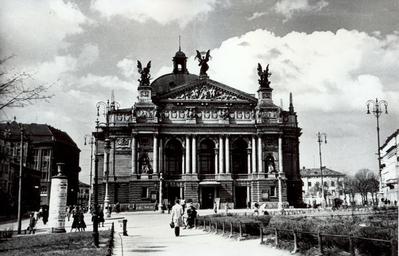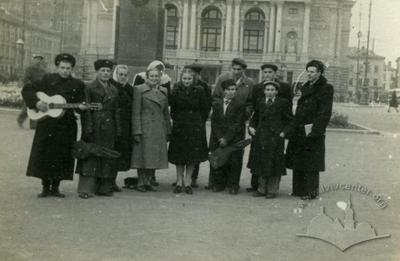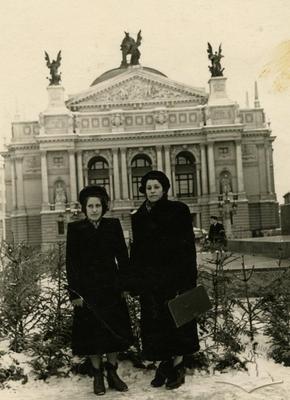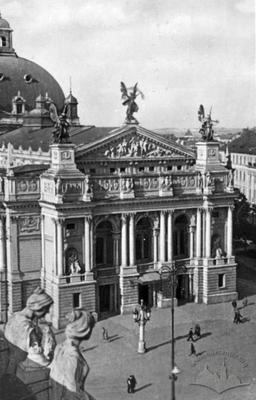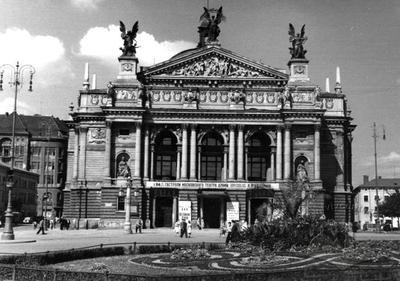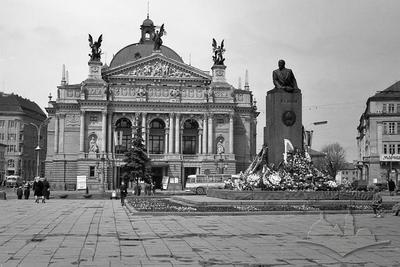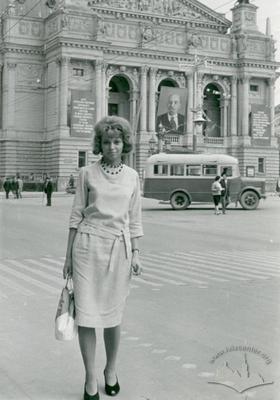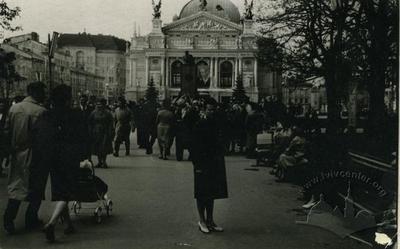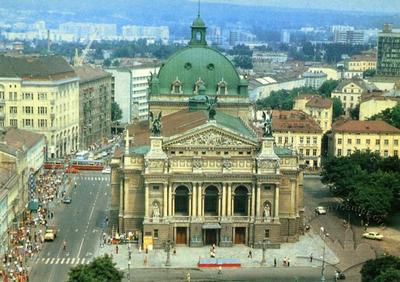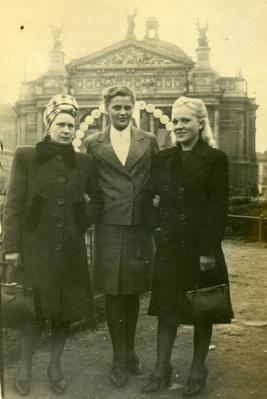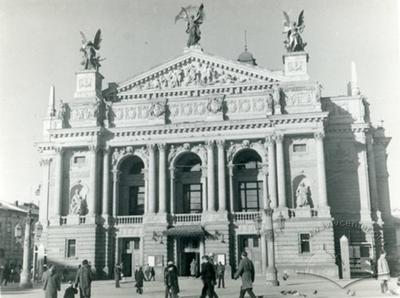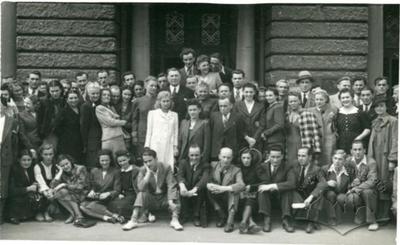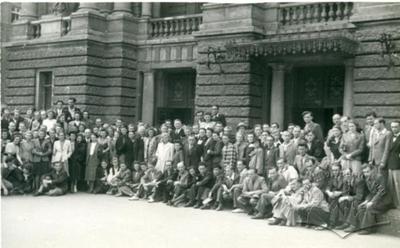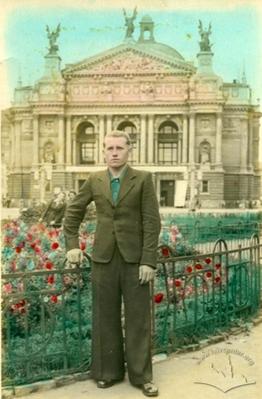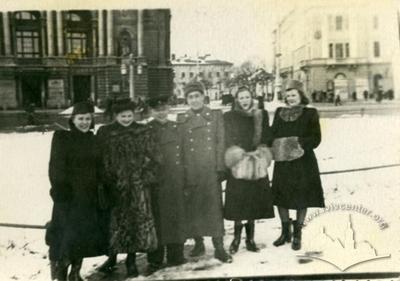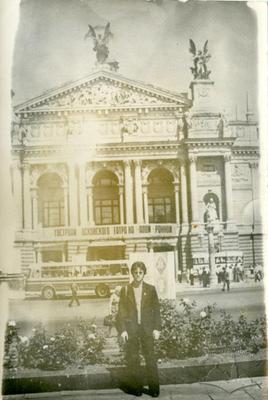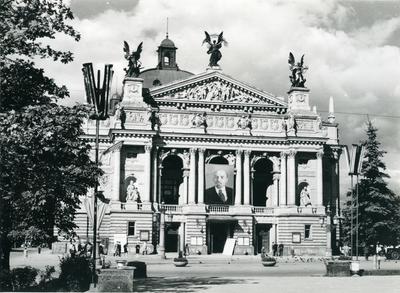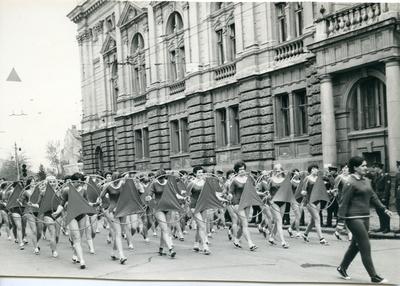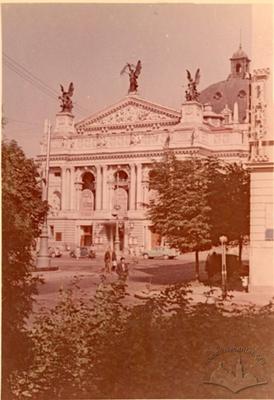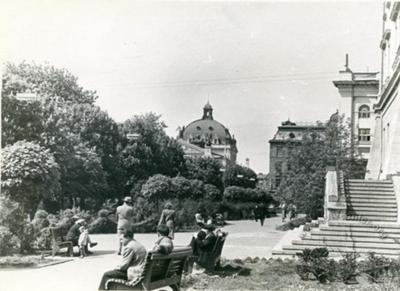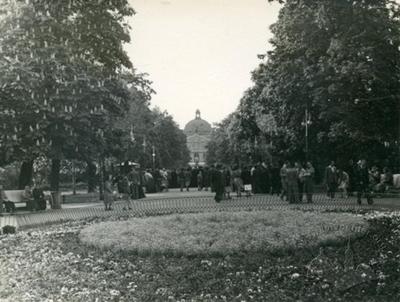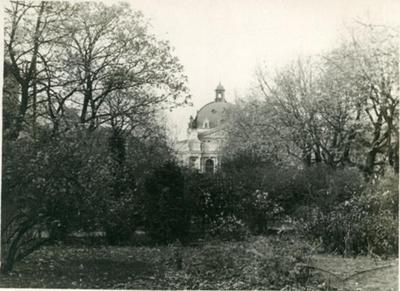Prosp. Svobody, 28 – Lviv Opera house ID: 367
The Lviv State Academic Opera and Ballet Theater was built in 1897-1900 under a project designed by architect Zygmunt Gorgolewski. The building is erected in historicist style and influenced by the so-called Vienna Neo-Renaissance. The monumental theater building has occupied a key position in the architectural ensemble of the city’s main avenue created in the late 19th – early 20th century.
Story
On 12 July 1895 a competition for the project of a new theater was announced by the Lviv's magistrate; however, due to the harsh conditions of the competition, only two projects were received by the Competition Committee before the deadline (1 January 1896). The first prize was given to a project entitled "Ludendo monet" designed by architect Zygmunt Gorgolewski, while the second one was given to a project "Justitia" designed by Jan Zawiejski.
Both architects were given time till 30 April 1896 to complete their projects. The competition was finally won by architect Zygmunt Gorgolewski, who was also the director of the Lviv Applied Art school. Many elements of the building's external and internal design were also executed under his projects later; it is for this building that he was decorated with the Order of the Iron Crown (3rd class) in 1901. Architect Jan Noworyta was his immediate assistant.
The theater was built in 1897-1900. To lay the theater's foundations, the architect proposed to change the channel of the river Poltva, which then flowed under the street from the side of what is now the Maria Zankovetska theater and under the Rizni square.
All the construction works were supervised by the Theater Building Committee, headed by the then president of the city Godzimir Małachowski. The Committee consisted of the vice-presidents of the city Michał Michalski and Stanisław Ciuchciński, who used to come to the building site every day; apart from them, the following members of the City Council were on the committee: architects and builders Andrzej Gołąb, Józef Kajetan Janowski, Wincenty Rawski; Polytechnic professors Roman Dzieślewski and Bronisław Pawelski; lawyers Edward Lilien and Alexander Mariański; University professor Ludwik Rydygier; doctor Edward Strojnowski. Zygmunt Gorgolewski (who acted as both artistic and technical construction manager), director of the city building administration Juliusz Hochberger, Magistrate advisor Bolesław Ostrowski, city engineer Maciej Czerny-Schwarzenberg, delegates of the Provincial Department (the Galician Sejm's executive body) Tadeusz Romanowicz and Wladysław Łoziński, a renowned historian and collector of art, were on the Committee too.
The construction works (including earth and concrete works, brickwork and stonework) were conducted by Ivan Levynskyi's (Jan Lewiński) and Józef Sosnowski's architectural and building company.
Earth works were started on 5 June 1897. The foundation pit (16,500 m3) was dug by hand. In so doing, the foundations of old fortification walls and the remains of oak piles were revealed, which once reinforced the banks of the Poltva. These foundations must have been related to the bastion on a little island, built in 1703 to protect the north-western corner of the Low Castle; it crossed the pit obliquely. On 21 August 1897 workers started to place concrete into the strip foundation under the future theater building. The foundation was approved by a special theater committee, led by Gwalbert Ziembicki and created by the Polytechnic Society members. The asphalt waterproofing was arranged by the asphalt and ruberoid factory owned by Stanisław Szeliga Łyszkiewicz.
Carpentry works were done by Krykiewicz's company, joinery by the company of the Wczeliak brothers, painting works by the company of Preidl and Kaczorowski, glass works by the company of Kupfer and Glanser, tin works by Henryk Bogdanowicz's company, blacksmith and locksmith works by the company of Gottlieb and Svoboda. Metal structures for the roof bridging and stage constructions were provided by the Sanok machines and carriages factory; electric lighting was arranged by the Siemens and Halske company from Germany. The ventilation of the opera theater was provided by the Johannes Haas company from Vienna in alliance with Władysław Niemeksza (1862-1905), a Lviv citizen. Fresh air came to the theater premises from a nearby booth (located near the side façade of the Stanisław Skarbek's old theater, now the Maria Zankovetska Theater).
In the booth, constructed in the shape of a rotonda, air was cooled and cleaned and then fed into the hall through a system of holes made in the floor. Used air was eliminated through a series of air vents located under the edges and in the four corners of the ceiling and covered with decorated gratings. These gratings were made according to drafts designed by the theater architect, Zygmunt Gorgolewski. Air was then brought out through four ventilation shafts, which were disguised as decorative lanterns at the corners of the theater's dome.
The theater was solemnly opened on 4 October 1900. Shortly, however, the soil under the theater began to sink to a greater extent than expected, and cracks began to appear in the theater walls. In the meantime, Zygmunt Gorgolewski died suddenly due to aortic paralysis in July of 1903.
The monumental main stage curtain, with its picturesque allegorical composition "Parnassus," is of high artistic value; Henryk Siemiradzki, a renowned academic-style artist who lived in Rome at that time, was commissioned to make it for the theater. The artist did not manage to implement the order in time before the opening of the theater, so the curtain was brought to Lviv on 16 October 1900 and was first demonstrated to the audience on 13 January 1901. Since 1967 this picture of Siemiradzki has been owned by the Lviv Art Gallery.
In 1978-1984 a reconstruction of the theater was carried out. It was at that time that the stage curtain was restored. It is protected carefully, and now it can be seen only at premiere performances and during major celebrations. A bronze sculpture of the theater patroness, famous Ukrainian singer Solomiya Krushelnytska, was placed in the center of the theater hall in 2002.
Architecture
The monumental building of the opera theater closes the perspective of the central avenue of Lviv, Svobody boulevard. It is built in the historicist style influenced by the so-called Vienna Neo-Renaissance. The symmetric spatial and planning structure of the building is typical of the European academic architecture of the 19th century.
The theater is built of brick and stone with metal structural elements; it is plastered and has the shape of an elongated rectangle in plan. The building has a reinforced concrete strip foundation (near the Poltva riverbed enclosed in an underground manifold).
The building façades are decorated according to the principles of classical order architecture. The horizontal cornices divide the building into three tiers. The lower tier is rusticated and accentuated by three portals on the main façade. The second tier has arched loggias separated by paired Corinthian columns; on the extreme compositional axes, there are niches with allegorical figures: "Comedy" with a mask and "Tragedy" with a stylus in hand. The sculptures were created by sculptors Antoni Popiel and Tadeusz Barącz. Spandrels of the loggia arches are decorated with allegorical figures: "Poetry" and "Music" on the right hand; "Glory" and "Fortune" in the center; "Comedy" and "Tragedy" on the left hand. The author of these statues was sculptor Stanisław Wójcik.
The façade is crowned with a developed attic having a pedestal and a triangular pediment. The pedestal is decorated with stone statues of muses created by sculptors Antoni Popiel, Julian Markowski, Tadeusz Wiśniowiecki, Juliusz Bełtowski. Between these statues, there are two high relief composition, "A Tribute to Poetry" (on the left) and "Homer Recites His Poetry" (on the right). In the pediment tympanum, there is a nine-figure high relief composition "The Joys and Sufferings of Life" (sculptor Antoni Popiel). These almost three-meter-tall figures are made of hydraulic lime mixed with cement and are attached to the wall and cornices with iron anchors. The pediment is completed with three acroterions, six-meter-tall bronze statues. They are located in the following manner: "Glory" (with a gilded palm branch) in the center, "Comedy and Drama" to the left on the pedestal and "Music" to the right. The author of these statues was sculptor Petro Viytovych (Piotr Wojtowicz).
A part of the building's sculptural decoration was made by sculptor Edmund Pliszewski according to Gorgolewski's drawings. In particular, there are escutcheons there, some of which are placed on the attic's pedestal. Tablets on these escutcheons had to contain inscriptions with the names of the most famous artists who performed in the theater. On the same pedestal on the main façade, there are two cartouches with coats of arms of Lviv held by statues of boys.
The building is topped with a massive dome having lucarnes and a skylight. There are bronze sculptures on both sides of the dome: sitting figures grouped around a lyre and a swan symbolizing music. They are created by Edward Podgórski according to Petro Viytovych's models at the A. Beschorner factory in Vienna.
The theater's interior décor includes gilding, marble, decorative painting and sculpture. The core of the internal planning structure is the four-tier theater hall (designed for 1800 spectators) in the form resembling a lyre. The hall consists of an orchestra surrounded with boxes on both sides, two balconies with boxes and the third balcony, which can be entered by separate entrances and stairs leading up from the building's lateral façades. There are 44 boxes in total there; one of them, located near the proscenium, was meant for the emperor and had a separate entrance. However, Francis Joseph I never visited the Great City Theater. Next, there is a massive prismatic block of the stage covered by a dome on the outside. The hall and the stage are surrounded on both sides with corridors having rows of utility rooms along them. The front part of the building's interior is occupied by a vestibule, a two-tier lobby and two flights of the main staircase which are arranged symmetrically.
The highlight of the stage is a decorative curtain "Parnassus" (1900) created by painter Henryk Siemiradzki who was well known in Europe; it depicts an allegorical interpretation of the meaning of life in the figures of Parnassus. For the convenience of the audience, the artist asked the theater administration to print an explanation of the painting.
The sculptural decoration of the hall was made under the supervision of Piotr Harasimowicz. Petro Viytovych, Edward Podgórski, Giovanni Giovanetti, and students of the Lviv Applied Art School were engaged in creating the decoration too.
Above the proscenium, there are sculptures of a winged Genius and a goddess of Arts (created by Petro Viytovych) keeping the coat of arms of the city of Lviv and a laurel branch. The theater hall's ceiling is decorated with a round plafond painted under the supervision of Stanisław Rejchan who was also the author of the "Apotheosis of Glory" plafond above the proscenium. The space around the chandelier above the theater hall is divided into ten sectors. Each of them has allegorical female figures placed in it: "Grace", turned to the center of the stage (created by Edward Miron Pietsch); "Truth", located to the right of the latter, with a looking glass (Tadeusz Popiel); then, in a circle, "Illusion", with a bubble (Antoni Stefanowicz); "Innocence" (Tadeusz Popiel); "Bacchante" (Stanisław Batowski); "Inspiration" (Aleksander Augustynowicz); "Drama" (Ludomir Kӧhler); "Critique", with a whip (Tadeusz Rybkowski); "Dance" (Zygmunt Rozwadowski); "Music" (Alexander Augustinowicz). Plaster bas reliefs depicting ten famous Polish actors of the late 19th – early 20th cc. are placed in a circle there too.
The theater's vestibule is also richly decorated with marble of different colours, gilding, decorative painting and sculpture. The central staircase leads from the vestibule to the theater hall, whose entrance portal is decorated with white marble statues: "Comedy" and "Tragedy", created by Petro Viytovych, and a bas relief of Zygmunt Gorgolewski created by Juliusz Bełtowski in 1907. Under the vestibule plafond, there are twelve paintings depicting allegories of the seasons, various arts and professions which are created by different artists led by Tadeusz Popiel. Among them, there are "The Symbols of Lviv Bourgeoisie" (Tadeusz Rybkowski), "Spring" (Tadeusz Popiel), "Peasants" (Zygmunt Rozwadowski), "Summer" and "Knighthood" (Tadeusz Rybkowski), "Sculpture" and "Autumn" (Tadeusz Popiel), "Science and Art" (Marceli Harasimowicz), "Winter" (Tadeusz Popiel), "Painting" and "Contemporary Music" (Domazy Kotowski), "Ancient Music" (Walerian Kryciński).
In the niches, there were busts of Polish poets Jan Kochanowski, Adam Mickiewicz, Ignacy Krasiński, and Juliusz Słowacki. After the 1984 restoration, only Adam Mickiewicz remained there while the others were replaced by busts of Taras Shevchenko, Ivan Franko, and Alexander Pushkin.
On the second floor, there is an entrance to the lobby (a mirror hall), which is decorated with four female allegorical sculptures created by Piotr Wojtowicz (over the archivolts of entrances leading to the side halls), "Love", "Envy", "Pride" (with a looking glass in hand), and "Motherhood". In addition, there are many decorative sculptures and bas reliefs created by Piotr Harasimowicz there.
In the niches above the mirrors, there used to be busts of Polish composers Frederik Chopin, Stanisław Moniuszko, Józef Elsner, Karol Kurpiński. In 1984 they were replaced by busts of composers Mykola Lysenko, Semen Hulak-Artemovsky, Piotr Tchaikovsky and Mikhail Glinka. A ceiling panel ("Dance", "Poetry", "Music") was created by Stanisław Dębicki, who also painted four square allegorical pictures under the lobby ceiling: "Love", "Hate" (a woman with a sword), "Justice" (with scales), "Wisdom" (with a paper scroll).
Under his supervision, artists Juliusz Zuber, Alexander Augustinowicz, and Stanisław Batowski created eight paintings representing the works of Polish drama popular in the late 19th c., such as "The Krakowians and Highlanders" by Wojciech Bogusławski, "The Carpathian Highlanders" by Józef Korzeniowski, "The Dismissal of the Greek Envoys" by Jan Kochanowski, "The Revenge" by Alexander Fredro, "Balladina" by Juliusz Słowacki, "Barbara Radziwiłłówna" by Ałojzy Feliński, "The Dandy’s Courtship" by Franciszek Zabłocki, and "Halka" by Stanisław Moniuszko. A bronze sculpture of the theater patroness, famous Ukrainian singer Solomiya Krushelnytska (1873-1952), was placed in the center of the theater hall in 2002.
People
Batowski, Stanisław (1866-1946) – artist
Ciuchciński, Stanisław (1841-1912) – Polish politician, vice president of Lviv in 1899-1907
Czerny-Schwarzenberg, Maciej – city engineer
Dzieślewski, Roman (1863-1924) – Lviv Polytechnic professor
Gołąb, Andrzej (1837-1903) – architect and builder
Harasimowicz, Piotr (1857-1914) – sculptor
Hochberger, Juliusz (1840-1905) – architect, the city building administration director
Janowski, Józef Kajetan (1832-1914) – architect and builder
Kӧhler, Ludomir (~1859-1915) – artist
Krushelnytska, Solomiya (1872-1952) – famous Ukrainian singer
Levynskyi, Ivan (Jan Lewiński) (1851-1919) – architect, co-owner of architectural and construction bureau which overlooked the construction of the Opera house
Lilien, Edward – lawyer
Łoziński, Wladysław (1843-1913) – delegate of the Provincial Department (the Galician Sejm's executive body), a renowned historian and collector of art
Łyszkiewicz, Stanisław Szeliga – owner of an asphalt and ruberoid factory
Mariański, Alexander – lawyer
Markowski, Julian (1846-1903) – sculptor
Michalski, Michał (1846-1907) – Polish politician, vice president of Lviv in 1895-1905
Noworyta, Jan – architect, Zygmunt Gorgolewski's assistant
Ostrowski, Bolesław – Lviv Magistrate advisor
Pawelski, Bronisław – Lviv Polytechnic professor
Pliszewski, Edmund – sculptor
Podgórski, Edward (1872-1931) – sculptor
Popiel, Tadeusz (1863-1913) – sculptor
Rawski, Wincenty (1850-1927) – architect and builder
Romanowicz, Tadeusz (1843-1904) – delegate of the Provincial Department (the Galician Sejm's executive body)
Rozwadowski, Zygmunt (1870-1950) – artist
Rybkowski, Tadeusz (1848-1926) – artist
Rydygier, Ludwik (1850-1920) – Lviv University professor
Siemiradzki, Henryk (1843-1902) – famous Polish artist
Sosnowski, Józef (1865-1940) – architect, co-owner of architectural and construction bureau which overlooked the
construction of the Opera house
Stefanowicz, Antoni (1858-1929) – artist
Strojnowski, Edward – doctor
Wiśniowiecki, Tadeusz (1845-?) – sculptor
Wójcik, Stanisław – sculptor
Zawiejski, Jan (1854-1922) – Polish architect
Ziembicki, Gwalbert – leader of the special theater committee, created by the Polytechnic Society
Sources
- Володимир Вуйцик, Роман Липка, Зустріч зі Львовом, (Львів: Каменяр, 1987).
- Павло Гранкін, "Вентиляція оперного театру", Ринок інсталяційний, №5 (89), 2004, 64.
- Павло Гранкін, Євген Соболевський, "Львівський оперний театр: історія будови і реставрації", Будуємо інакше, №2 (2000), 42-45.
- Павло Гранкін, Євген Соболевський, "Львівський оперний театр: історія будови і реставрації", Будуємо інакше, №1 (2001), 37-47.
- M. Lityński, Pamiątkowy opis teatru miejskiego we Lwowie, (Lwów: Z drukarni E. Winiarza, 1900).
- Mieczysław Orłowicz, Przewodnik po Lwowie, (Lwów, 1925).
Urban Media Archive Materials
